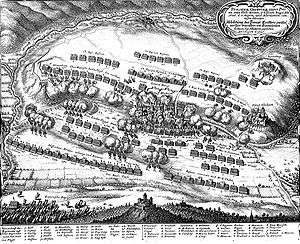Battle of Nördlingen (1645)
| ||||||||||||||||||||||||||||||
The second Battle of Nördlingen (or Battle of Allerheim) was fought on August 3, 1645 southeast of Nördlingen near the village of Alerheim. France and its Protestant German allies defeated the forces of the Holy Roman Empire and its Bavarian Catholic league allies.
Prelude
The Imperials and the Catholic League were facing increasingly severe pressure in the war from the French, Swedes and their Protestant allies and were struggling to prevent a French attempt to advance into Bavaria.
Geography
The 12,000-man Imperial-Bavarian army, led by Field Marshal Franz Baron von Mercy and Johann von Werth entrenched on rising ground near the village of Alerheim, 10 km southeast of Nordlingen. One km to the northeast of the village, the ridge rises to a height called the Wennenberg. Exactly 1 km to the southwest of the village is the Schloss Alerheim, which crowns a hill. Mercy and Werth deployed their right wing on the Wennenberg, anchored their left wing on the schloss (castle) hill, and posted their center on the low ridge between the wings. In the 17th century, Alerheim was smaller and entirely to the northwest of the Imperial battleline between the Wennenberg and the schloss. To protect their weak center, the Bavarian and Imperial officers had some dismounted dragoons and foot soldiers barricade themselves in the village. They hoped to defeat the French by forcing them into a disadvantageous attack uphill into the fire of the Imperial cannon.
Battle
Before the battle, Marshal Henri, Vicomte de Turenne united his Franco-German army with an all-French army led by Louis II de Bourbon, Prince de Condé (then known as the Duc d'Enghien, courtesy title of the heir to the Condé honours, to which he would not succeed until the following year). The combined army of 12,000 men was placed under Condé's overall leadership.[1] Condé's tactics were brutally simple. He intended to launch the French troops in a frontal charge on the Imperial positions. Meanwhile, it took the French army from noon until 4:00 pm to arrange its lines for battle.
In the event, the Imperial army counterattacked almost at once. Charging downhill from Schloss Alerheim, they broke Condé's hesitant right wing, forcing the Frenchman to call off his attack on the Imperial center. On the other end of the field, Turenne hammered at the Wennenberg. When the Wennenberg fell, the defeated Imperial right swung back and the victorious left wheeled forward, so that the Imperials faced north instead of northwest. Mercy was killed during the savage fighting. By evening, both armies were still on the field of battle. However, in the darkness and confusion, the Imperials in the village, believing themselves to be surrounded, capitulated. Later that night, the Imperial army conceded defeat and withdrew.
Result
The Franco-German losses were 5,000 killed, wounded, and captured, including a large number of officers. The Bavarian-Imperial army suffered similar losses. When Condé fell sick, he withdrew his army to French territory, leaving Turenne unsupported. Turenne eventually fell back to Philippsburg.[2] Therefore, the only French gain from the bloody victory was their capture of Nördlingen and Dinkelsbuhl. The Imperials were able to fall back to Donauwörth in reasonably good order to make good their losses. Bavaria was at least temporarily safe. Eventually the battle provided no more than a breathing space and did not prevent the invasion of Bavaria the following year.
References
| Wikimedia Commons has media related to Battle of Nördlingen (1645). |
- Dodge, Theodore Ayrault. Gustavus Adolphus. Boston: Houghton, Mifflin & Co., 1890.
- Eggenberger, David. An Encyclopedia of Battles. New York: Dover Publications, 1985. ISBN 0-486-24913-1
Footnotes
- ↑ Eggenberger, p 308. Dodge writes that the French had 19,000 and the Imperials 16,000.
- ↑ Eggenberger, p 308.
Coordinates: 48°51′00″N 10°37′00″E / 48.8500°N 10.6167°E
